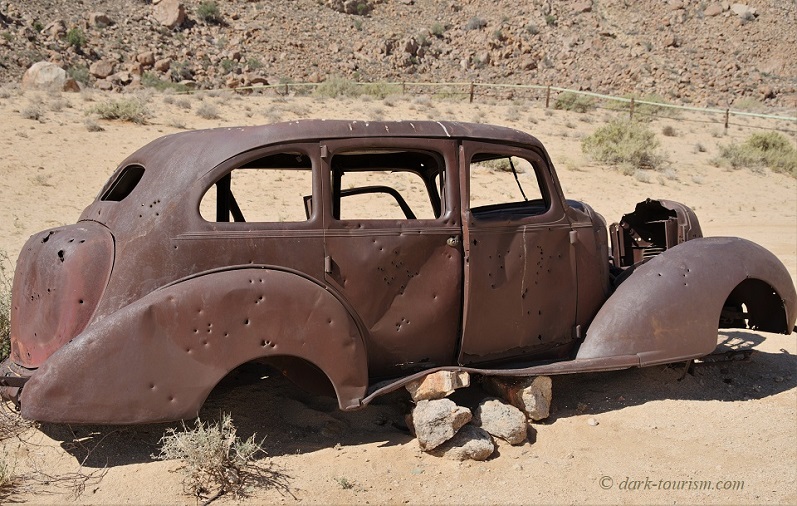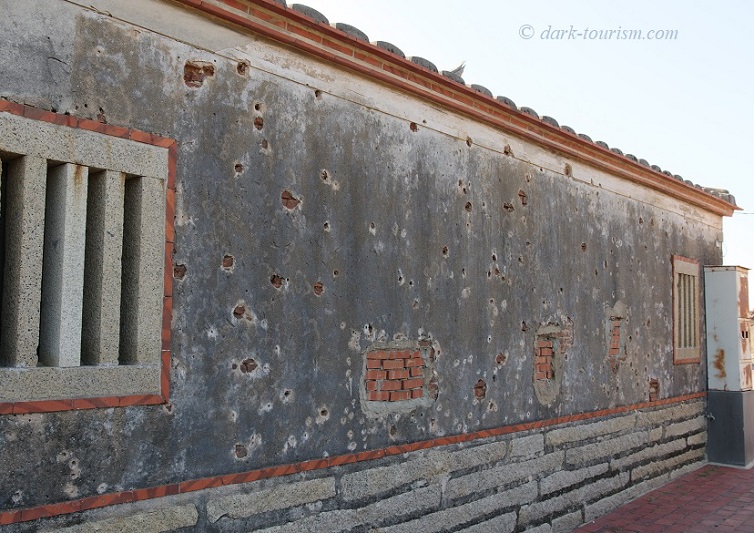This is the winning theme from the latest poll (see previous Blog post), which is also the one that had come second in the poll before that (see this post) and was thus eligible for another chance. And it narrowly took it. This time things were much tighter, however. A close second was DT & Graffiti, just one vote behind. And if I were now to cast my own vote also for graffiti that would make it a tie. So instead of fielding it again in another poll I will just make DT & Graffiti one of the coming posts.
But now to this post’s theme – bullet holes:
An especially famous bullet hole is one of the dark star attractions at the Military History Museum here in Vienna (Heeresgeschichtliches Museum – HGM): it’s in the bloodied uniform worn by Archduke Franz Ferdinand when he was assassinated at the Latin Bridge in Sarajevo in 1914 (which was the trigger for WW1) – the bullet hole just below the collar is marked with a little arrow (my addition):

Another associated bullet hole can be found right next to the uniform display, namely the one from the other shot fired by the assassin that also killed Franz Ferdinand’s wife after it first went through the rear part of the open-top car they were being driven around in. The whole car is another star attraction in this ensemble at the HGM:

The next photo shows an exhibit at the Free Derry Museum in the Bogside of Derry/Londonderry in Northern Ireland; it’s the jacket worn by Michael McDaid who was shot dead on Bloody Sunday, with the hole torn by the bullet that killed him marked by a little yellow arrow (in this case it’s the museum’s addition not mine):

Not a real bullet hole, but quite a drastic artistic depiction of one, I found on a bas-relief at The Residency in Lucknow, India. It is part of the commemoration of the Indian rebellion of 1857 in which the British enclave called The Residency was laid under siege and several British colonialists and members of their families were killed:

Quite possibly the most drastic bullet hole in my photo archive is this next one, in the skull of a soldier killed at the Battle of Gallipoli in WW1 – with the deadly bullet still stuck in its hole! – on display at a visitor centre in Kabatepe, Turkey, where I took this photo in 2007:

To prevent this sort of death, soldiers have long worn steel helmets in battle – but those do not necessarily provide the protection they promise, as drastically illustrated by this exhibit at the war museum in Gori, Georgia:

The unlucky chap who was wearing this helmet got at least five bullets in the head that penetrated the helmet. But when it comes to multiple deadly bullet holes, then this next photo is a star example – this was the car Bonnie and Clyde were killed in:

Actually, it’s not the real thing, but only a film prop from a movie about Bonnie and Clyde – but close enough for inclusion here. It was on display at the former Museum of Crime and Punishment in Washington D.C., USA.
Neither a replica nor a museum piece is this similarly perforated car in the next photo:

Allegedly this car was used in a real-life attempt at smuggling a cache of diamonds illegally taken from the “Sperrgebiet” in southern Namibia (see also Kolmanskop, Pomona and Elizabeth Bay). The two diamond thieves were eventually tracked down by the police at this location near Aus and killed in a gunfight (but the diamonds were never found again!).
The next photo shows some bullet holes in the window of an airbase hangar in Pearl Harbor, Hawaii, which are relics from the Japanese attack on Pearl Harbor on 7 December 1941 (same photo as the featured one at the top of this post):

I saw (and photographed) them in 2015 during a visit to what was then the “Pacific Aviation Museum”, meanwhile renamed “Pearl Harbor Aviation Museum”.
Pearl Harbor was a decisive moment in WWII in that it dragged the USA into the war. Another decisive moment was the Battle of Stalingrad, the big turning point in the European “theatre” when Nazi Germany’s fortunes turned against it – the catastrophically lost Battle of Stalingrad, a major victory for the Soviet Red Army, proved to be the beginning of the end for the Third Reich, as it were. Here’s a photo of some original bullet holes from that battle in what today is Volgograd:

Back to the place where I live these days, Vienna. In a corner of St Marx cemetery I found a tombstone still bearing dozens of bullet holes from the Battle of Vienna when the Red Army finally reached the Austrian capital too:

In the German capital Berlin, meanwhile, a symbol of the Nazi era, a bell from the Olympic Games of 1936, also suffered a direct hit by a shell leaving a big hole. The bell is now on display outside the historic Olympic Stadium. Note also the feeble attempt at altering the little swastika on the bottom rim of the bell:

And now to yet another capital city that played a major role in the WWII era: Tokyo, Japan. Very few remnants of the war can still be seen in that city, this is a rare exception, seldom on any tourists’ itinerary due to its suburban location far from the city centre. It’s an electric substation that is totally pockmarked with bullet holes from strafing American fighter planes:

Going back further in time, this is a wall at Jallianwala Bagh in Amritsar, India, still bearing bullet holes (marked by little white squares) from the massacre perpetrated by British colonial forces in 1919:

Moving further east, here’s a bullet-hole-riddled and scorched ruin from the Vietnam War near the DMZ:

Going further east still, here’s another bullet-hole riddled wall, this time in Beishan on the small island of Kinmen, a territory of Taiwan but close to the Chinese mainland, from where the island was shelled up until the 1970s:

One of the most drastically bullet-hole-riddled buildings I’ve ever seen was in Sarajevo. This war ruin was a complex intended to become an old people’s home but was still unfinished and unoccupied when the Siege of Sarajevo began in the Yugoslav wars of the 1990s. My guide explained that the building was deliberately hit so disproportionately because some Serbian soldiers not so keen on shooting at Bosnian civilians emptied their allocated rounds of ammunition on this place as they knew there was nobody inside:

While this war ruin is still there in this state, just even more overgrown by now, this next war ruin that was similarly pockmarked with bullet holes when I saw it in Mostar in 2009 is most likely no longer there in this state:

One of the earliest battle sites of the Yugoslav wars was Vukovar in Slavonia in eastern Croatia. Here the old train station is amongst the war ruins that have been preserved. This, as you can see, is riddled with bullet holes too:

Some very impressive bullet-hole scars can also be found on a set of old grain silos just outside Vukovar:

Also quite pockmarked with bullet/shell holes is this building at Camp Kigali in the Rwandan capital city:

This was a barracks used by Belgian UN peacekeeping soldiers who were deliberately targeted on the first day of what would become the Rwandan genocide, namely in order to provoke a withdrawal of UN troops. And indeed, after ten Belgian soldiers had been killed at Camp Kigali, the UN, together with most other foreigners, did largely evacuate. After that the genocide escalated more or less unhindered.
On a lower scale of darkness is the next set of bullet holes – on a historical marker in the USA’s Washington State near the Hanford Site. This was the formerly top-secret place where the world’s first large-scale nuclear reactor was built, which produced the plutonium used in the first-ever nuclear explosion at the Trinity test site as well as that for the Nagasaki bomb. The bullet holes, on the other hand, are just evidence of the American trigger-happy obsession with firearms. Why anyone would want to shoot at a historical marker is a mystery to me, though …:

Finally, here’s an example of fake bullet holes, just added for dramatic effect, namely on the Gate of Freedom Memorial monument that commemorates the Iron Curtain at Devin near Bratislava in Slovakia at the border with Austria.

But so much for this post’s theme. Next will come the theme Dark Tourism & Graffiti. I can’t yet say when, though, as I am busy with work for my main website. Now that this has undergone some technical updates and a slight redesign I have to push on with overdue chapters on Taiwan for the website. That’s now my priority so the Blog will have to play second fiddle for a while.
Please also note that there remains a problem with some hyperlinks on the redesigned website and, more importantly, with the links to it from this Blog. In all older posts the links to specific place chapters have been lost (they currently lead to 404 error messages), but we hope to find a way to restore them somehow. Fingers crossed!




One Response
This post offers an exciting and thought-provoking journey through history, with each bullet hole telling a powerful story of conflict and its lasting impact. It’s a captivating exploration that beautifully connects past events to present-day reflections.